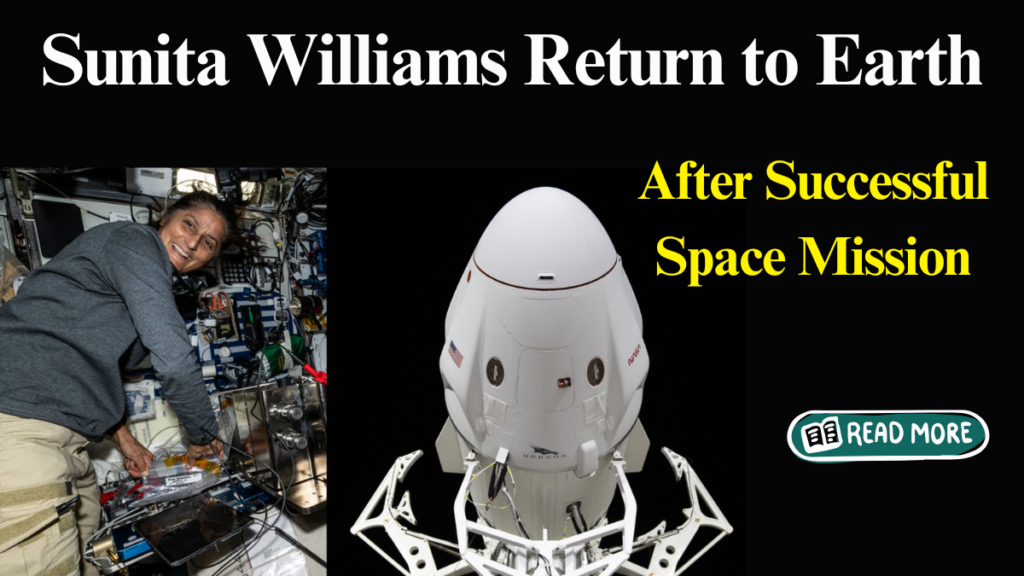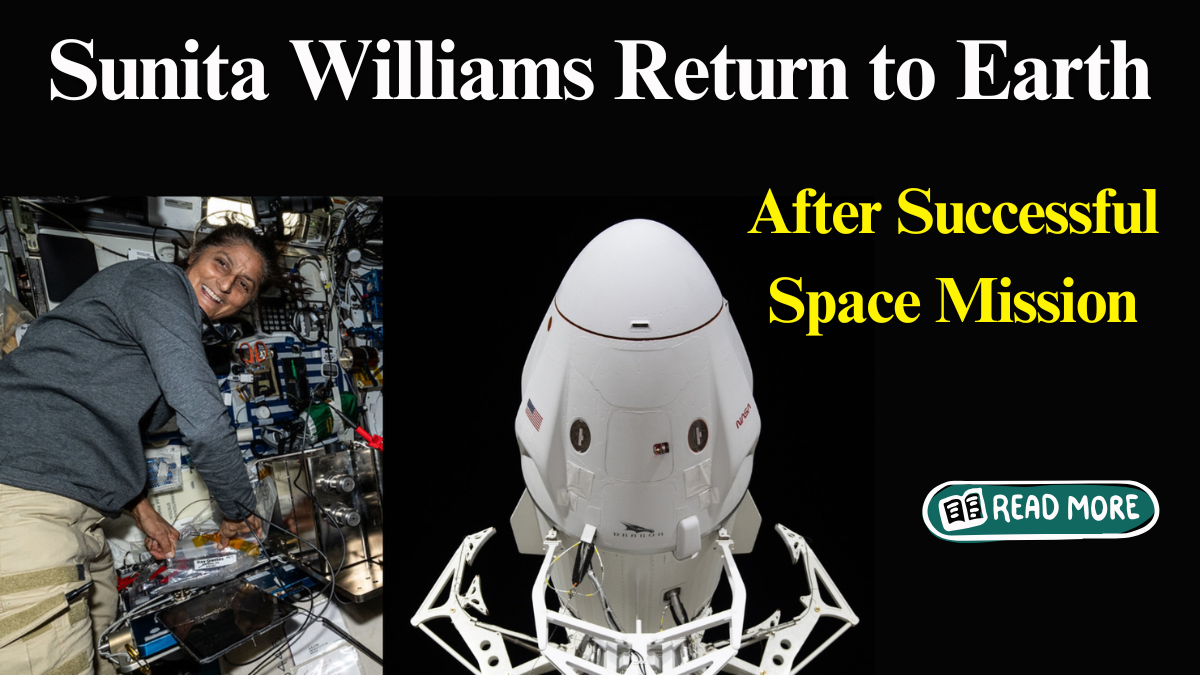NASA astronaut Sunita Williams is set to return to Earth after completing a successful mission aboard the International Space Station (ISS). The undocking process, which marked the beginning of her journey home, was completed successfully, signaling the end of her extended stay in space. This article provides an in-depth look at Williams’ journey, her mission on the ISS, and what her return home means for space exploration.

Sunita Williams: A Trailblazer in Space Exploration
Sunita Williams has been a prominent figure in space exploration. As an astronaut with NASA, she has made significant contributions to the advancement of science and technology, particularly during her time aboard the ISS. Williams, who holds the record for the most spacewalks by a woman (seven), was a part of several missions, including her long-duration stay at the ISS.
Her work on the ISS has included scientific experiments, repairs to the space station, and the testing of new technologies aimed at supporting future missions to the Moon and Mars. Williams’ dedication to space exploration has inspired countless individuals worldwide, especially women pursuing careers in STEM fields.
Undocking: The First Step Towards Her Return
The undocking process marks the first step in any astronaut’s return to Earth. Sunita Williams, along with her fellow astronauts, was aboard the SpaceX Dragon spacecraft when they undocked from the ISS. This spacecraft is designed to carry astronauts back to Earth safely after extended missions in space.
The undocking itself is a carefully coordinated operation, ensuring that the spacecraft is separated from the ISS without incident. After undocking, the spacecraft begins its journey back to Earth, entering the Earth’s atmosphere and landing either in the ocean or on land, depending on the mission’s objectives.
In Williams’ case, the undocking was a smooth and successful process. The crew on board the SpaceX Dragon spacecraft prepared for reentry, ensuring that all systems were functioning properly. This is an important moment in the mission, as astronauts’ lives depend on the accuracy and precision of each step.
A Successful Mission at the International Space Station
Williams’ mission aboard the ISS was focused on scientific research, technology testing, and preparing for future space missions. During her time in space, Williams conducted numerous experiments related to biology, physics, and human health in microgravity. These experiments are crucial for understanding how the human body reacts to long-term exposure to space environments, which will be key to supporting future deep-space missions, such as a journey to Mars.
One of the key aspects of Williams’ mission was her participation in spacewalks, which are essential for maintaining the ISS and conducting repairs. Spacewalks involve astronauts leaving the safety of the spacecraft and performing tasks in the vacuum of space. Williams is particularly well-known for her skill and experience during these spacewalks.
Her time on the ISS also included testing new technologies that will play a critical role in future missions. For example, some of the equipment she tested is aimed at making space travel more efficient and sustainable, particularly for long-duration missions.
The Challenges of Living and Working in Space
Living aboard the ISS is no easy task. Astronauts face a number of challenges, from the physical effects of microgravity to the mental strain of being away from family and Earth for extended periods. Sunita Williams and other astronauts undergo intense training to prepare for these challenges. They learn how to adapt to life in space, including how to deal with changes in bone density, muscle mass, and cardiovascular health.
Microgravity, or the feeling of weightlessness, causes astronauts to experience several physiological changes. These include muscle atrophy and the weakening of bones due to the lack of gravitational force. Space agencies like NASA continuously study these effects to develop countermeasures that can help astronauts maintain their health during long missions.
Another major challenge astronauts face is the psychological impact of isolation. While aboard the ISS, astronauts spend months at a time in a confined space, away from their families and friends. Maintaining mental health is a critical part of space missions, and astronauts like Williams undergo psychological training to ensure they can handle the mental and emotional challenges of space.
Looking Ahead: The Future of Space Exploration
Sunita Williams’ successful mission aboard the ISS is a step forward in space exploration. Her work, along with that of many other astronauts, is helping to lay the groundwork for future missions to the Moon, Mars, and beyond. NASA’s Artemis program aims to return humans to the Moon, with the goal of establishing a sustainable human presence there by the end of the decade.
In the coming years, astronauts like Williams will play key roles in these missions. The lessons learned from their time aboard the ISS will be vital in ensuring the success of longer, more complex missions, including the first crewed missions to Mars.
NASA and other space agencies around the world are also exploring new technologies that will make space travel safer, more efficient, and more sustainable. These include advanced propulsion systems, better space habitats, and ways to produce food and water in space, which are essential for long-term missions.
What Happens Next for Sunita Williams?
Now that Sunita Williams has completed her mission aboard the ISS, her focus will shift to her return to Earth and what comes next. Like many astronauts, she will likely be involved in post-mission debriefings, which are essential for improving future space missions. These debriefings help space agencies understand what went well during the mission and what could be improved.
Williams’ return will also mark the end of one of her most challenging and rewarding space missions. As she re-enters Earth’s atmosphere, her spacecraft will experience extreme temperatures, but the technology behind the spacecraft is designed to protect the crew and ensure a safe landing.
Once back on Earth, Williams will be celebrated for her accomplishments in space and her contributions to the field of space exploration. While she has not announced her next steps, it’s clear that she will continue to inspire future generations of astronauts and scientists.
Key Facts About Sunita Williams’ Return
| Event | Details |
|---|---|
| Undocking Date | Sunita Williams’ spacecraft undocked from the ISS recently. |
| Spacecraft Used | SpaceX Dragon capsule. |
| Mission Focus | Scientific research, spacewalks, and technology testing. |
| Record | Sunita Williams holds the record for most spacewalks by a woman. |
| Next Steps | Williams will undergo post-mission debriefings and focus on future space missions. |
Conclusion
Sunita Williams’ return home after completing a successful mission aboard the ISS is a momentous occasion in the history of space exploration. Her work has helped pave the way for future missions and has contributed significantly to the understanding of life in space. As space exploration continues to evolve, Williams’ contributions will remain an important part of the journey to the Moon, Mars, and beyond. Her return to Earth is not just the end of a mission, but a new beginning for the future of human space exploration.
FAQ
Why is Sunita Williams’ return significant?
Sunita Williams’ return marks the successful completion of another important space mission. Her work in space is crucial for advancing our understanding of space travel and preparing for future missions to the Moon and Mars.
What is the process of undocking from the ISS?
Undocking is the process in which a spacecraft separates from the ISS. It requires careful coordination to ensure the spacecraft safely detaches and begins its journey back to Earth.
What are the main challenges astronauts face aboard the ISS?
Astronauts face physical challenges like muscle atrophy and bone density loss due to microgravity, as well as mental health challenges related to isolation and being away from family for long periods.
What is next for Sunita Williams?
After returning to Earth, Williams will be involved in post-mission analysis and may continue to play a role in future space missions.
Click here to learn more.
Pari is a passionate writer known for captivating stories that blend imagination and reality. Inspired by travel, history, and everyday moments, Pari crafts narratives that resonate deeply with readers.
